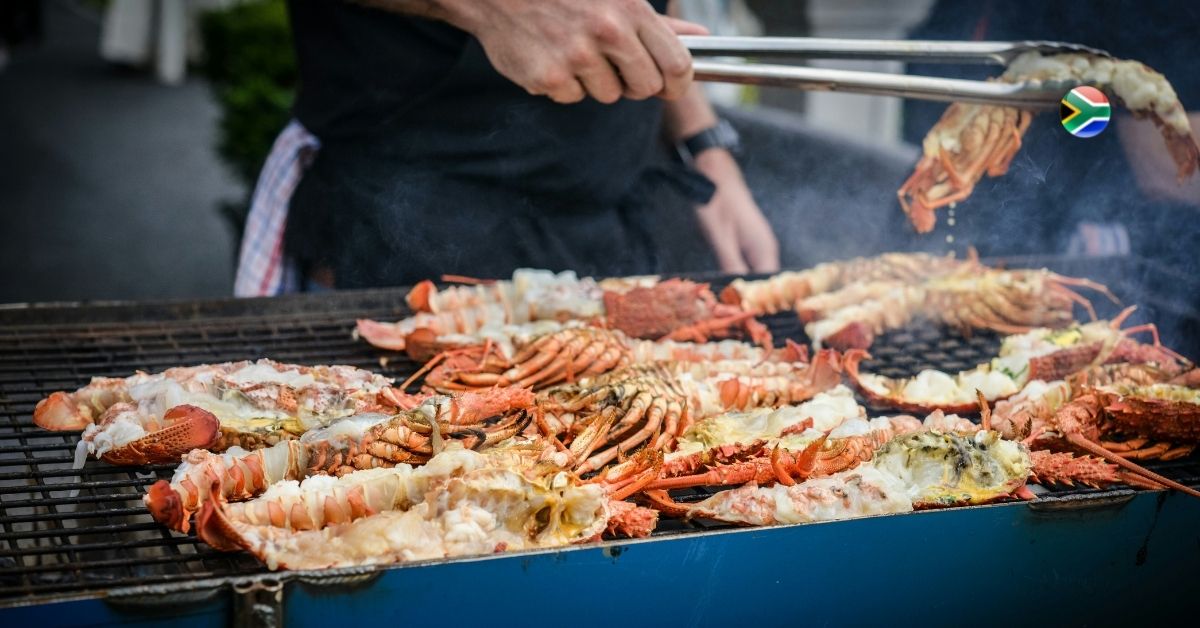
South African crayfish, also called the spiny lobster, rock lobster, or kreef in Afrikaans, are known for their spiny shells and long antennae. Their natural habitat is along the east and west coasts of South Africa, where they can be found hiding under rocky outcrops or simply cruising along the seabed.
You may be interested to know there are two varieties of lobster available in South Africa, West Coast Rock Lobster (Jasus Lalandii) and East Coast Rock Lobster (Panulirus Homarus). Both are equally delicious; however, the West Coast Rock lobster is endangered due to overfishing.
The South African Sustainable Seafood Initiative (Sassi) has placed this crayfish on its red list due to population decline. This means strict regulations govern when and how many of these crayfish you may catch at any one time. Time frames for fishing are tight, with crayfish season usually lasting a mere twelve days, numbers are limited to four per person, and it’s illegal to sell your catch commercially or to friends. Failure to follow the rules can result in steep fines and possible jail time. Therefore this slow-growing crustacean is not often seen on dinner plates today unless you are eating at an eye-watering expensive restaurant.
If you want to enjoy a tasty crayfish, you have to head to a restaurant or store that buys and subsequently sells sustainable seafood.
Kreef
From humble beginnings to delicacy
Once the small-scale fishermen’s evening meal, crayfish was caught and simply prepared to feed his hungry family. Nowadays, the white sweet tasting meat of the crayfish is a much sought-after delicacy. Previously thought of as vermin fishermen would throw these critters back into the sea if accidentally caught in their nets. They were even sold as fertiliser to farmers in the old days. Fast forward to today, where crayfish is super expensive and considered a luxury South African food if you can afford it.
Where to get a delicious serving of crayfish
Quickly recapping on the above history lesson, crayfish are delicious and considered a luxury food. Crayfish diving is governed by strict regulations, which, if ignored, could find you sitting in jail licking the lemon butter off your fingers at your leisure.
This doesn’t mean that crayfish is off the menu. On the contrary, there are many places in South Africa that you can still go crayfish diving as long as you have the relevant permit and follow the rules. For example, Elands Bay in the Western Cape is a well-known crayfish-ing spot in South Africa. The season usually lasts from mid-November to April, attracting many tourists and locals alike. At places such as these, you can still enjoy your crayfish braai on the beach. The fact it’s such a delicacy is sure to make the crayfish meat taste all the sweeter.
Alternatively, you could purchase your crayfish from reputable supermarket suppliers or fishmongers. Purchasing your crayfish from licensed suppliers ensures that small-scale fishing communities are able to make an affordable living while ensuring that crayfish are fished in a sustainable and environmentally friendly way. The ‘Abalobi’ initiative works hard to educate the general public about such matters, with fishermen collecting data and selling their catch to reputable and traceable supply chains. Abalobi is a non-profit organisation based in South Africa whose focus is on contributing to sustainable small-scale fishing communities globally.
Regulations, habitat, and variations aside, crayfish is ultimately a great-tasting South African seafood. If you can get your hands on any, that is!
Nothing says good South African food, quite like crayfish on the beach. And by good food, we invariably mean braai food. Surprisingly cooking crayfish is very simple and doesn’t require fancy cooking methods or intricate recipes. This is because of the meat’s sumptuous flavour, which doesn’t need heavy sauces or spices to make it a truly delicious dish.
Let’s jump into a good old-fashioned South African seafood recipe.
Garlic crayfish on the braai
What you need:
- 6 crayfish (fresh)
- 4 crushed garlic cloves
- 200g of melted salted butter
- 1 tbsp of freshly squeezed lemon juice
What to do:
- Combine the crushed garlic and melted butter into a smooth paste
- Add the lemon juice to the paste and mix thoroughly.
- Using a sharp knife, cut down the center of the crayfish tail shell.
- Pick the crayfish up by the tail and place it meat side down on the braai grid.
- Use a basting brush to spread the garlic butter and lemon juice over the crayfish tails.
- Use a pair of braai tongs and turn the crayfish over after four minutes. Cook the crayfish for a further fifteen minutes.
- Continue to baste the tails with the garlic butter during the entire cooking process.
- Remove from the braai grid when cooked and allow to cool slightly.
Serve with a crisp white wine and chunks of crusty garlic bread. Alternatively, simply eat this delicacy straight from the shell as the ocean intended, and we’ll forgive you any nostalgia felt about long ago braai’s on the beach in the evening sun.
FinGlobal – The place of fine recipes & exceptional financial emigration assistance
If you love the recipe we shared above, there’s something you’ll love even more: our services! At FinGlobal, we provide services to assist South African expats and soon-to-be expats with financial emigration, retirement annuity withdrawal from abroad, FOREX, tax clearance, exchange control, tax exit, inheritances, and more. If you wish to discuss your unique situation with us before heading abroad, we would be more than willing to listen and provide helpful advice – simply get in touch with us. You can reach us by telephone on 028 312 2764 or email us at info@finglobal.com. We can’t wait to assist you further!